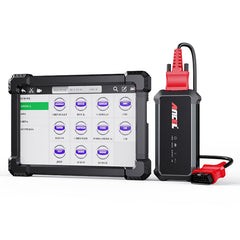Understanding your car’s fuel economy is crucial for both your wallet and the environment. While traditional methods like tracking mileage and fuel consumption provide a general overview, many wonder if an OBD2 scanner can offer more precise insights. This article explores the relationship between OBD2 data and fuel economy, examining how these tools can help you understand and improve your vehicle’s efficiency.
How OBD2 Scanners Work
OBD2 scanners connect to your car’s computer system, accessing a wealth of data from various sensors. This data includes engine speed, coolant temperature, oxygen sensor readings, and more. While fuel economy isn’t directly displayed as a single reading, the OBD2 provides the raw data necessary to calculate and understand the factors influencing it.
Indirect Fuel Economy Indicators from OBD2 Data
Several OBD2 parameters offer indirect insights into fuel economy:
1. Short-Term and Long-Term Fuel Trim
Fuel trim readings indicate adjustments made by the engine control unit (ECU) to maintain the optimal air-fuel ratio. Positive fuel trim values suggest the ECU is adding fuel, potentially indicating a rich mixture that negatively impacts fuel economy. Conversely, negative values indicate reduced fuel, often associated with a lean mixture. Consistently high positive fuel trim could signal underlying issues like a faulty oxygen sensor or fuel injector, leading to poor fuel efficiency.
2. Mass Air Flow (MAF) Sensor Readings
The MAF sensor measures the amount of air entering the engine. Inaccurate MAF readings can disrupt the air-fuel mixture, affecting combustion efficiency and fuel consumption. An OBD2 scanner can reveal unusual MAF sensor behavior, pointing towards potential problems.
3. Oxygen Sensor Readings
Oxygen sensors play a critical role in maintaining the correct air-fuel ratio. Fluctuating or out-of-range oxygen sensor readings, detectable through an OBD2 scanner, can indicate issues that lead to decreased fuel economy. Replacing a faulty oxygen sensor often improves fuel efficiency.
4. Engine Load
Engine load reflects how hard the engine is working. Higher engine loads typically correlate with increased fuel consumption. Monitoring engine load using an OBD2 scanner, alongside other parameters, provides a more comprehensive understanding of fuel usage patterns.
5. Engine Coolant Temperature
An engine operating outside its optimal temperature range can negatively impact fuel efficiency. The OBD2 scanner allows you to monitor coolant temperature, ensuring the engine is running within the ideal range for optimal combustion.
Using OBD2 Data to Improve Fuel Economy
By monitoring the parameters mentioned above, you can identify potential issues affecting fuel economy. Addressing these problems, such as replacing faulty sensors or correcting a rich/lean fuel mixture, can lead to significant improvements in mileage. Furthermore, observing real-time data like engine load and speed allows you to adjust your driving habits for better fuel efficiency.
Conclusion
While an OBD2 scanner doesn’t directly display fuel economy in miles per gallon or liters per 100 kilometers, it provides invaluable data for understanding the underlying factors influencing it. By analyzing parameters like fuel trim, MAF sensor readings, and oxygen sensor data, you can diagnose issues impacting fuel efficiency and take corrective measures. Combining this data with mindful driving habits can lead to significant improvements in your vehicle’s fuel economy.


